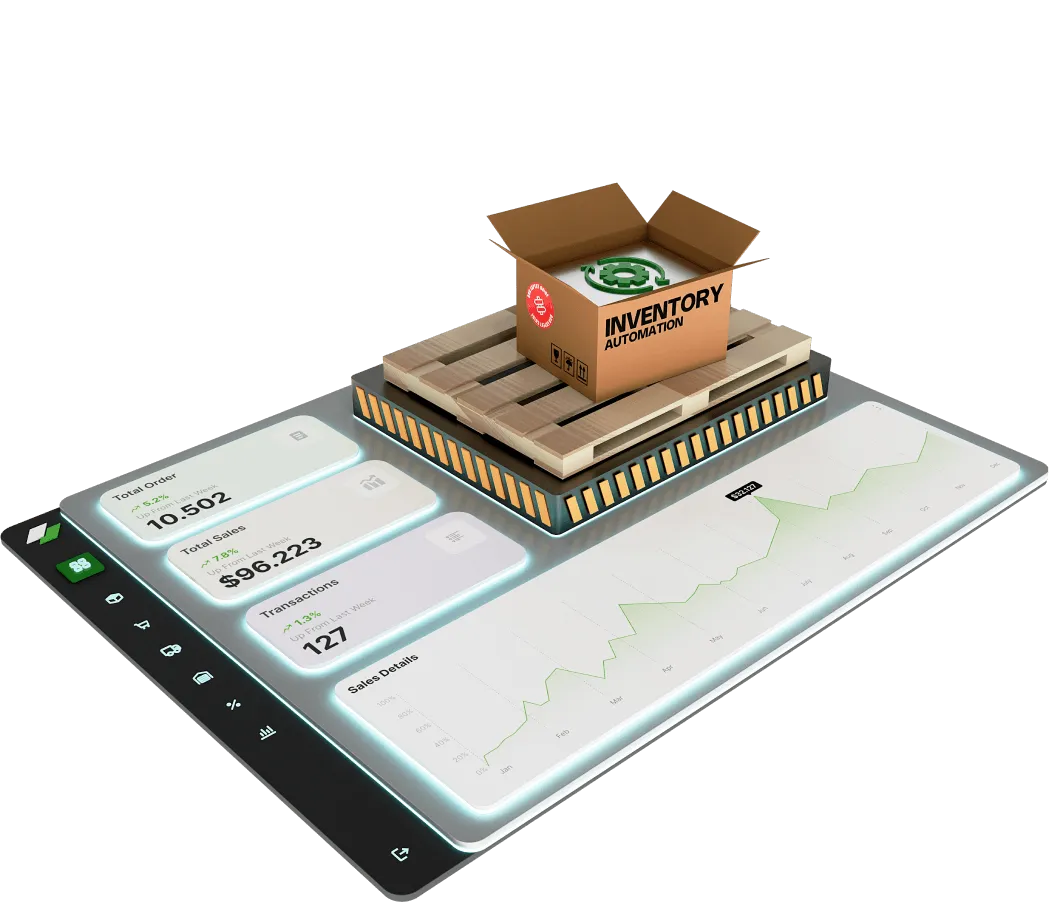Forget spreadsheets and stockroom guesswork — inventory automation is stepping in as the smart brain behind modern supply chains. Thanks to advancements in artificial intelligence, businesses are now rethinking the way they handle stock, supplies, and demand planning. Intelligent systems that learn, adapt, and optimize in real-time can now manage tasks that once required hours of manual oversight.
If you’re running a business, you’ve likely felt the pressure of demand that changes overnight, supply chain disruptions you didn’t see coming, and the ongoing need to keep things efficient without wasting resources. It’s a lot to juggle. But smart technologies are stepping in to help. By 2025, these intelligent solutions are expected to completely transform how companies like yours handle stock, anticipate customer needs, and stay agile in a fast-paced market.

In this guide, we’ll walk you through how this shift is unfolding, what’s working right now, what trends are on the horizon, and how forward-thinking businesses are already putting it into action. You’ll discover the practical benefits, the challenges to keep in mind, and, most importantly, how to start using these tools to make your day-to-day operations smoother and more reliable.
Before we dive into how technology is reshaping the way your business can handle stock and supply flows, it’s worth understanding how operations have traditionally been done. At its core, managing goods has always been about ensuring products move efficiently from the production line to storage facilities and, ultimately, into the hands of customers.
Interestingly, inventory automation statistics highlight impressive gains in both efficiency and output. In fact, a global study by Gartner, Inc., which surveyed over 1,300 supply chain professionals, revealed that 87% are planning to invest in stronger, more adaptable operations in the coming years. This shift touches on several critical aspects of product flow and fulfillment.
Traditionally, these tasks have been handled manually or with basic digital tools. However, AI is raising the bar, bringing speed, precision, and smarter decision-making into every step of the process.

Luckily for us, due to the digital progress, custom inventory management systems are no longer a manual grind. Thanks to accounting and inventory automation, businesses are trading spreadsheets and guesswork for intelligent systems that run processes with speed, precision, and minimal human input.
Besides, blockchain technology has the potential to increase supply chain transparency if you use it in your business. In 2019, the technology adoption rate was just 8%, but it has the potential to increase to 45% by 2030.
On that note, here’s how you can transform the way your business handles stock flow, demand planning, and supply operations, making everything run smarter and more efficiently.
Forecasting no longer has to be a shot in the dark. Mechanization takes over by analyzing everything from historical sales and seasonal patterns to current market shifts and customer behavior.
With these insights, you can maintain optimal stock levels, avoiding overordering or the risk of empty shelves. The automated inventory system works around the clock, adjusting forecasts as new data comes in, so you stay ahead of demand instead of constantly reacting to it.
Imagine being able to accurately track the status of every product across all your locations, all without requiring any manual intervention. Using tools like RFID tags and IoT sensors, these systems track movement in real time, updating counts as goods flow through your supply chain.
This level eliminates manual tracking errors but also ensures immediate alerts when something’s off, so you can take action before it turns into a costly problem.
Managing restocks manually can be time-consuming and error-prone, but smart systems are changing that. The entire replenishment process is now handled digitally, with automatic triggers that kick in when levels fall below a set threshold.
These tools factor in everything from supplier reliability to how quickly items are selling and typical delivery timelines. It functions as a continuous support system, ensuring that your shelves remain stocked and your operations function smoothly.
Smart technology goes far beyond just tracking stock—it’s also transforming how goods move behind the scenes. From organizing storage more efficiently to guiding the fastest picking routes, intelligent systems are streamlining every step of the process.
Tools like ERP platforms, Autonomous Mobile Robots (AMRs), and Robotic Process Automation (RPA) are taking over time-consuming tasks such as sorting, retrieving, and packing. As a result, you get faster fulfillment, lower labor costs, and greater accuracy without the bottlenecks of manual handling.
Advanced inventory automation systems can intelligently segment your goods based on real-time performance, product lifecycle, seasonality, and more, eliminating the need for manual sorting or endless categorization.
This smart classification allows you to tailor your approach: fast-moving items are prioritized for restocking, slower sellers are stored more strategically, and you gain sharper decision-making power without constantly having to micromanage.

Adopting modern solutions goes beyond simply updating your tech stack and drives meaningful improvements across your entire supply chain. Take, for example, Zara, a global fashion leader that uses advanced tracking technology to keep pace with rapidly changing trends and customer needs.
By employing RFID and real-time monitoring, Zara follows each product’s journey from production to store shelves, enabling fast and accurate restocking based on actual sales. This system allows Zara to replenish stock within days, reduce excess goods, and minimize markdowns. It also helps the company react quickly to market shifts, making it possible to launch new collections faster than competitors. This smart approach to stock management is a key driver of Zara’s efficiency and agility.
Let’s see what other significant advantages, including cost savings, operational efficiency, and a stronger customer experience, automated inventory software offers.
Manual tasks slow you down and leave room for error. AI takes over time-consuming processes like replenishment, warehouse inventory tracking, and order fulfillment, running them faster, more accurately, and without breaks.
Systems monitor in real time and keep everything flowing smoothly, freeing up your team to focus on higher-value work.
Having the right products available and delivering orders on time leaves a strong impression, and it’s what keeps customers coming back. Intelligent systems support this by refining how you track stock and anticipate demand, so you're always ready when it counts.
The result is fewer delays, no more “out of stock” surprises, and a more reliable experience that builds lasting customer loyalty.
AI goes beyond task execution and brings clarity that empowers smarter decision-making. By analyzing every layer of your supply network, you uncover valuable insights into areas like pricing, performance, and logistics.
Whether you're responding to shifting market conditions or planning your next phase of growth, robotization equips you with the knowledge to act confidently and strategically faster and with greater precision.
With technological demand forecasting and optimization, you can finally stop utilizing the costly extremes of overstocking and stockouts. Having too much inventory can drain your capital and incur storage fees, while having too little inventory can lead customers to your competitors.
It maintains optimal stock levels, minimizes waste, enhances turnover, and safeguards your financial performance.

This technology is only beginning to unfold, and the future of stock control is poised to become smarter, faster, and more seamlessly connected. As business automation solutions continue to advance, here are some important trends that proactive companies need to watch closely.
Imagine having a secure, tamper-proof record of every product’s journey from production to delivery. Blockchain technology makes this level of transparency and trust possible. When combined with intelligent systems, this powerful duo gives businesses unparalleled visibility into their stock.
While blockchain ensures trustworthy automated inventory tracking, smart tools use that information to streamline decisions and fine-tune supply flows, reducing fraud, delays, and blind spots.
The fulfillment center of tomorrow will blend the physical and digital worlds seamlessly. Using augmented reality (AR) enhanced by intelligent systems, workers will wear smart glasses or use devices that display live information such as product locations, available quantities, or picking instructions right in their line of sight.
At the same time, these smart systems will analyze ongoing activity to optimize layouts and drive continuous improvements, creating smarter workflows in real time.
Robotics in hospital inventory management software is shifting from basic functions to full autonomy. Next-gen AI-driven robots and drones won’t just follow scripts, but they’ll make intelligent decisions, adapt to real-time changes, and collaborate with human teams.
Whether it’s scanning shelves, restocking products, or picking orders, these machines will take on more responsibility with greater speed and accuracy.
Far from being a passing trend, sustainability has become a critical priority for businesses today. Intelligent technologies will be key in helping companies shrink their environmental impact through smarter stock management strategies. By reducing excess goods and packaging waste, optimizing delivery routes, and improving energy use in storage facilities, these innovations make it easier to run operations both efficiently and responsibly.
Integrating smart technology into your stock management process requires more than just installing new tools. It calls for careful planning and a solid foundation. To set your business up for long-term success, here is a step-by-step approach to follow.
Real-time inventory automation is quickly becoming a key driver of operational success across industries. It enables businesses to anticipate demand more accurately, keep stock levels balanced, and ensure that supply flows are smooth and responsive in a fast-paced global market.
While there may be initial challenges such as setup costs, system integration, and team onboarding, these are short-term concerns. The long-term gains are substantial: leaner operations, lower expenses, and a sharper competitive edge.
Businesses that embrace these advancements now will be far better positioned to grow, adapt to market shifts, and consistently deliver on customer expectations, leaving slower movers struggling to keep pace.
At CleverDev Software, we’re here to guide you through this transformation with customized solutions built around your specific goals. Reach out to us today, and let’s unlock the full value of your operational records together.


Our newsletter is packed with valuable insights, exclusive offers, and helpful resources that can help you grow your business and achieve your goals.